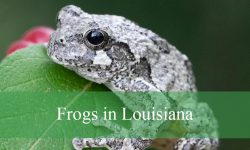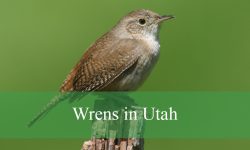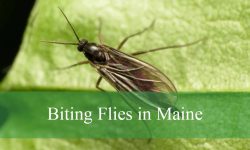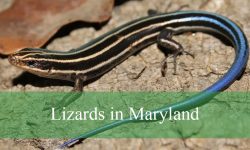Utah is a state known for its striking landscapes, ranging from vast deserts and sandstone canyons to lush mountain forests and alpine meadows. These diverse habitats are not only breathtaking for visitors but also home to an impressive array of wildlife. Among the most intriguing creatures found in Utah are its wild cats. These secretive predators are seldom seen by humans, but their presence is an essential part of the state’s ecosystems.
The wild cats of Utah vary greatly in size, behavior, and habitat preference. From the small and elusive bobcat to the powerful mountain lion and the rarely encountered Canada lynx, each species plays a unique role in maintaining balance in the wild. They are top predators that help regulate populations of prey animals, ensuring that ecosystems remain healthy and functional.
In this article, we will explore three types of wild cats found in Utah. You will learn about their physical characteristics, habitats, hunting behavior, and the best ways to identify them in the wild. We will also cover the best times and places to observe them, along with some common questions people have about these remarkable animals.
Bobcat in Utah
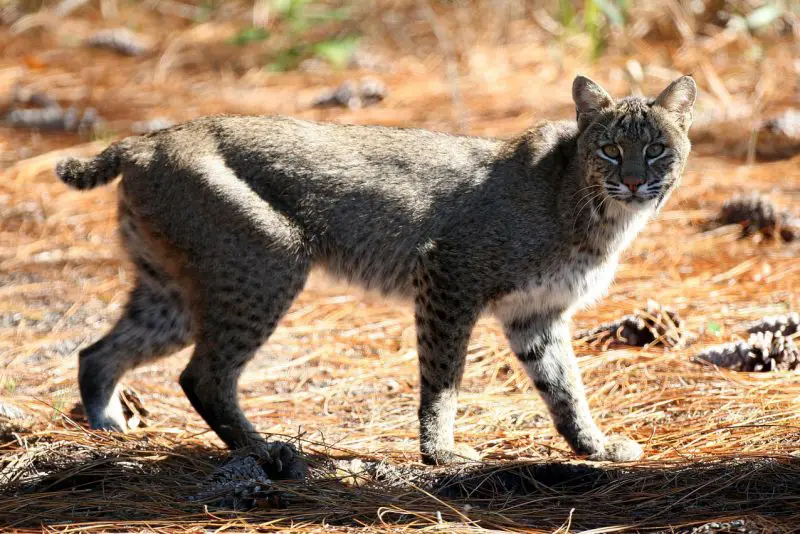
Characteristics and Identification
The bobcat (Lynx rufus) is the most widespread wild cat in Utah and is also one of the most successful predators across North America. Despite being considered a “medium-sized” wild cat, it is surprisingly powerful for its size. Adult bobcats usually weigh between 15 and 35 pounds, with males often being larger than females. Their body length typically ranges from 24 to 40 inches, while the tail adds only a few inches more, giving them their trademark “bobbed” look that inspired their name.
The bobcat’s fur provides exceptional camouflage in Utah’s rugged landscapes. Its coat color can vary depending on the region, ranging from tawny brown in desert areas to grayish tones in forested habitats. Most bobcats are marked with black spots, streaks, and rosettes across their bodies, which break up their outline and make them nearly invisible when resting in brush or rocky terrain. Their ears are tipped with small black tufts, similar to those of their northern cousin, the Canada lynx, though much shorter. Another distinguishing feature is their tail: the upper side ends in black, but the underside is white. When raised, this white underside is clearly visible and can help differentiate them from lynx.
Bobcats also have a distinctive facial appearance. Longer cheek ruffs frame their faces, giving them a wild, almost bearded look. Their eyes are sharp and yellowish, adapted for excellent night vision, which aids their crepuscular and nocturnal hunting habits. Overall, their combination of stealth, agility, and camouflage makes them perfectly adapted predators for Utah’s diverse environments.
Habitat and Distribution
One of the reasons bobcats thrive in Utah is their incredible adaptability. Unlike some wild cats that depend on specialized habitats, bobcats can survive in deserts, canyonlands, mountain forests, shrublands, and even on the outskirts of suburban neighborhoods. Their ability to exploit a variety of environments has allowed them to maintain healthy and stable populations across the state.
In the southern parts of Utah, bobcats are often found among the red-rock canyons and desert plateaus, where rocky outcrops provide excellent dens and hunting grounds. In central Utah, they take advantage of mixed shrublands and foothill zones, often using dense thickets for cover. In the northern mountains, bobcats inhabit coniferous and mixed forests, where snow cover and prey availability shape their seasonal activity. They are also commonly associated with riparian areas, where water sources attract rabbits, rodents, and birds.
Even though they are widespread, bobcats are rarely seen in the wild. Their secretive nature and preference for dense cover make direct encounters uncommon. However, evidence of their presence can often be found in tracks, scat, and occasional kills left behind. Tracks are usually about two inches wide, round, and lack claw marks, since bobcats, like most cats, retract their claws while walking.
Behavior and Diet
Bobcats are solitary by nature, with males maintaining much larger territories than females. A male’s home range can stretch over 20–30 square miles, while a female’s may be as small as 5–10 square miles. These ranges often overlap, but bobcats use scent marking and vocalizations to avoid direct confrontation.
They are primarily crepuscular, most active during dawn and dusk. However, bobcats are highly opportunistic and will adjust their activity patterns depending on prey availability and human presence. In remote desert areas of Utah, they may even hunt during daylight hours.
Their diet is diverse, making them one of the most versatile predators in the state. Rabbits and hares—particularly cottontails and jackrabbits—form the bulk of their diet, but they also consume rodents, squirrels, birds, reptiles, and occasionally young deer. Bobcats are ambush hunters. They rely on patience, silently stalking their prey through vegetation or rocky terrain until they are close enough to launch a powerful leap. With sharp claws and strong jaws, they are capable of dispatching prey quickly.
During winter, when prey becomes scarce in higher elevations, bobcats often move to lower valleys and desert regions, following rabbit populations and taking advantage of easier hunting conditions. Their ability to adapt their diet and movements to seasonal changes is another reason they thrive in Utah’s diverse landscapes.
Importance and Human Encounters
Bobcats play a critical role in Utah’s ecosystems by controlling populations of small mammals and rabbits, which, if left unchecked, could overgraze vegetation and destabilize habitats. In this way, they contribute to maintaining ecological balance, benefiting both plant and animal communities.
Human encounters with bobcats are rare, and they are generally not considered dangerous to people. They are shy and reclusive, choosing to avoid human activity whenever possible. However, in suburban or rural areas near wild habitats, bobcats sometimes come into conflict with humans by preying on chickens, small pets, or domestic turkeys. Wildlife officials typically remind residents to secure outdoor enclosures and avoid leaving pet food outside, which can attract bobcats and other predators.
While bobcats are legally classified as a furbearer in Utah and can be hunted or trapped with a license, populations remain stable thanks to careful management by the Utah Division of Wildlife Resources. Conservationists highlight that these cats are a vital part of Utah’s natural heritage, and seeing one in the wild is considered a rare and special experience.
Mountain Lion in Utah

Characteristics and Identification
The mountain lion (Puma concolor), also widely known as cougar, puma, or panther, is the largest wild cat roaming Utah’s landscapes. Adult males typically weigh between 110 and 150 pounds, while females are smaller, averaging 80 to 110 pounds. In length, they can reach up to 8 feet from nose to tail tip, with the tail alone accounting for about one-third of the body. This long tail is essential for balance, especially when moving through Utah’s steep cliffs, rocky ridges, and canyon walls.
The coat of the mountain lion is usually a uniform tawny or sandy brown, although it can appear grayish in colder climates or more reddish in desert environments. Their underparts, including the chest and inner legs, are lighter in color, often whitish or pale cream. The muzzle and chin also have lighter fur, creating a strong facial contrast, while the tip of the tail is distinctly black. Unlike bobcats or lynx, mountain lions lack spots and ear tufts, giving them a sleek, solid-colored appearance.
Their physical build emphasizes stealth and power. Mountain lions have muscular limbs designed for leaping and sprinting short distances, and their retractable claws help them climb trees or grapple with prey. Their eyesight is excellent, adapted for low-light hunting, and their hearing is sensitive to the slightest movement of prey. When observed in the wild, they appear elegant yet imposing—an apex predator perfectly shaped by evolution to dominate its environment.
Habitat and Distribution
Mountain lions are widely distributed across Utah, though their numbers vary depending on prey availability and human pressures. They are strongly associated with mule deer populations, since deer make up the majority of their diet. Because of this, the best habitats for mountain lions in Utah are regions where deer thrive—rugged mountains, canyonlands, and foothill forests.
In the northern part of the state, they are often found in the Wasatch Range and Uinta Mountains, where thick forests and rocky outcroppings provide excellent cover. In central Utah, canyon systems and shrublands offer hunting grounds, while in the southern regions, cougars adapt to desert canyonlands and plateaus, often seeking shelter in cliffs and caves during the heat of the day.
Although mountain lions are highly adaptable and capable of living in a wide variety of environments, they typically avoid wide-open deserts with little cover as well as heavily urbanized areas. Still, sightings near the edges of cities or rural communities do occur, especially when prey such as deer move into these areas. Their elusive behavior makes them difficult to see, but evidence such as large round paw prints (about 3–4 inches wide), scrapes in the soil used for scent marking, or cached deer carcasses can reveal their presence.
Behavior and Hunting
Mountain lions are solitary predators, with males maintaining expansive territories that may exceed 100 square miles. Females occupy smaller home ranges, generally 20 to 60 square miles, but these ranges can overlap with those of multiple males. Mountain lions communicate indirectly through scent marking, scratches on trees, and vocalizations that include hisses, growls, and the eerie, high-pitched screams of females during breeding season.
They are ambush hunters, relying on patience and stealth rather than speed. A mountain lion will stalk quietly, using vegetation, rocks, or terrain for concealment, before leaping onto its prey in a sudden burst of power. Their muscular hind legs allow them to leap up to 18 feet vertically or 40 feet horizontally in a single bound. With strong jaws and sharp claws, they deliver a precise killing bite to the neck of their prey.
In Utah, mule deer are by far their most important food source, but cougars are opportunistic and will take a variety of animals, including elk calves, bighorn sheep, porcupines, raccoons, coyotes, and smaller mammals. They are also known to occasionally prey on livestock, which can bring them into conflict with ranchers. After a kill, mountain lions usually drag the carcass to a secluded spot and cover it with leaves, dirt, or snow, returning to feed over several days. This caching behavior helps them protect their food from scavengers like coyotes and vultures.
Mountain lions are most active during dawn and dusk, though they can also hunt at night. Their secretive lifestyle means that many Utah residents live in mountain lion country without ever seeing one, even though the cats may be watching from a distance.
Conservation and Human Safety
As apex predators, mountain lions are vital to Utah’s ecosystems. By controlling deer populations, they prevent overbrowsing of vegetation, which helps maintain healthy habitats for countless other species. Without predators like cougars, deer herds can grow unchecked, leading to habitat degradation that affects both wildlife and human interests such as grazing and forestry.
Human encounters with mountain lions in Utah are rare, but because of the animal’s size and strength, they can be alarming. The Utah Division of Wildlife Resources advises hikers and residents in cougar country to take precautions: avoid hiking alone, keep children close, and never run if confronted by a lion. Instead, people should stand tall, make themselves appear larger, speak firmly, and back away slowly. In the very rare case of an attack, fighting back aggressively is recommended.
Conflicts with livestock and pets do occur, especially when cougars wander into rural or suburban areas following deer. Wildlife managers address these situations by relocating problem animals or, in some cases, removing them. Utah regulates cougar hunting through a permit system, which is used both for recreational purposes and to help manage populations in balance with prey availability and human tolerance.
Despite these challenges, mountain lion populations in Utah remain stable, and the species continues to be a symbol of wilderness and natural balance. Seeing one in the wild is a rare privilege, offering a glimpse into the secretive world of one of North America’s most powerful predators.
Canada Lynx in Utah
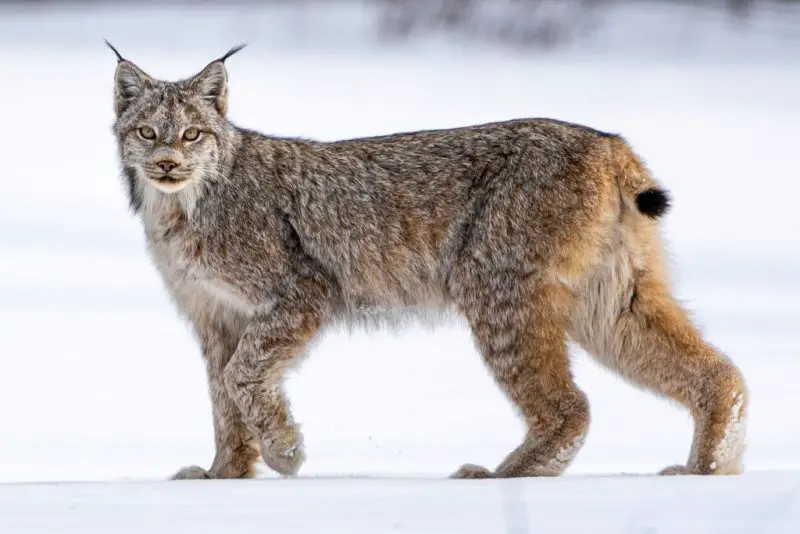
Characteristics and Identification
The Canada lynx (Lynx canadensis) is the rarest of Utah’s wild cats and is not considered a permanent resident of the state. This medium-sized wild feline is larger than the bobcat, with long legs, tufted ears, and oversized, furry paws that act like natural snowshoes in deep snow. Adult lynxes typically weigh between 18 and 30 pounds and measure about three feet in body length, excluding their short, stubby tail.
Their coat is soft and pale grayish-brown, often marked with faint spots, and their tail is tipped entirely in black—a clear distinction from the bobcat’s tail, which has a white underside with dark bands. One of the most striking features of the lynx is its long ear tufts, which are significantly longer than those of bobcats. When combined with their wide, heavily furred feet, these adaptations make the Canada lynx unmistakable when compared to Utah’s other wild cats.
Habitat and Rarity in Utah
Canada lynxes are strongly associated with boreal forests in Canada, Alaska, and parts of the northern Rocky Mountains. In Utah, they are extremely rare, and biologists consider them transient visitors rather than resident animals. Most sightings are anecdotal and come from the high-altitude coniferous forests of northern Utah, particularly near the Wyoming and Idaho borders.
These elusive cats depend heavily on habitats with deep winter snow, where their specialized paws give them an advantage over competitors. Because Utah lies on the southern edge of their historical range, the state does not support an established lynx population. Instead, individuals occasionally wander into Utah’s mountain forests from more northern regions, making confirmed encounters very unusual.
Diet and Behavior
The Canada lynx is a highly specialized predator, with its survival closely tied to the abundance of snowshoe hares. In fact, snowshoe hares make up the majority of its diet in northern habitats. Their population cycles directly affect lynx numbers, creating a predator-prey relationship that fluctuates every decade or so.
In Utah, where snowshoe hare populations are less abundant, lynxes—if present—would likely adapt by hunting small mammals such as squirrels and chipmunks, along with birds found in alpine forests. They are solitary, secretive hunters, primarily active at night. Even in areas where lynxes are relatively common, they remain elusive and difficult to observe in the wild.
Conservation and Status
The Canada lynx is classified as a threatened species under the U.S. Endangered Species Act, and protections are in place across its American range. In Utah, the species is officially considered a rare visitor rather than a permanent resident, and hunting or trapping them is strictly prohibited.
Although sightings in Utah are unlikely, the occasional presence of Canada lynx underscores the state’s ecological connection to the greater Rocky Mountain ecosystem. Protecting high-altitude coniferous forests and ensuring the health of prey species, particularly snowshoe hares, may help maintain suitable conditions for these rare visitors. For wildlife enthusiasts, simply knowing that such an elusive predator may occasionally pass through Utah’s mountains adds another layer of wonder to the state’s rich biodiversity.
Best Time and Places to See Wild Cats in Utah
Spotting a wild cat in Utah requires patience, luck, and knowledge of their habits. Bobcats are the most likely to be seen, especially at dawn and dusk in rocky desert regions, canyonlands, and foothill areas. Mountain lions are more elusive, but tracks and deer kills can often be found in the Wasatch and Uinta Mountains, as well as in the central canyonlands.
The Canada lynx is nearly impossible to encounter in Utah, but hikers in northern high-altitude forests may occasionally be lucky enough to spot tracks in the snow. Winter is often the best time to see evidence of wild cats, since tracks stand out clearly.
Wildlife watchers should always use caution, observe from a distance, and avoid disturbing these predators. Carrying binoculars, looking for fresh tracks, and visiting areas with abundant deer or rabbits increases the chance of an encounter.
FAQs about Wild Cats in Utah
Are there black panthers in Utah?
No, black panthers do not exist in North America. Reports of black panther sightings in Utah are usually misidentifications of mountain lions in low light or of large domestic cats.
Are wild cats dangerous to humans?
Wild cats in Utah are generally shy and avoid humans. Bobcats pose almost no threat, while mountain lions can be dangerous in rare cases. Following safety guidelines, such as not hiking alone and avoiding running if you encounter one, greatly reduces risks.
Can wild cats be found near cities in Utah?
Yes, bobcats are sometimes seen near urban areas where food is available, such as rabbits and rodents. Mountain lions occasionally wander close to towns near the foothills, but they typically avoid populated areas.
What should you do if you encounter a mountain lion?
Stay calm, do not run, and make yourself look larger by raising your arms or opening your jacket. Maintain eye contact, speak firmly, and slowly back away. If attacked, fight back aggressively.
Are Canada lynx protected in Utah?
Yes, the Canada lynx is listed as threatened in the United States and is fully protected in Utah. They are extremely rare in the state and are considered occasional visitors rather than residents.
Conclusion
Utah’s wild cats represent some of the most fascinating and elusive predators in the state. The bobcat is common and widespread, the mountain lion is powerful and majestic, and the Canada lynx is a rare and mysterious visitor from the north. Each species has unique adaptations that allow it to survive in Utah’s varied landscapes, from deserts to alpine forests.
Although sightings are rare, evidence of these cats is all around for those who know where to look. Their presence is a reminder of Utah’s wildness and the importance of preserving natural habitats for future generations. Protecting these top predators ensures that Utah’s ecosystems remain balanced, diverse, and thriving.

